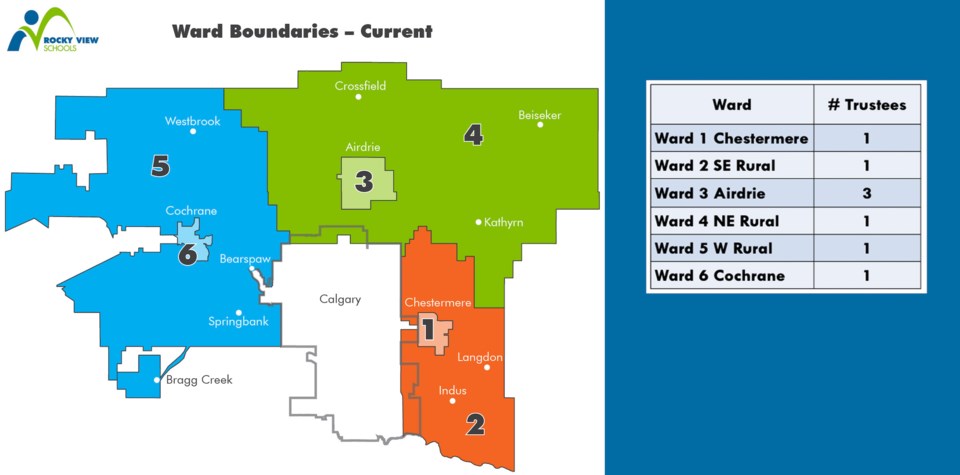Despite limited feedback from the public, Rocky View Schools (RVS) got its first impressions from the public of what potential changes to the current wards may look like.
The RVS Board of Trustees received its commissioned Ward Boundary review report for information at the Sept. 19 meeting.
Most of the responses leaned towards the status quo, citing drawbacks such as decreased rural representation among the new boundaries, as well as cost increases if they add another trustee.
Since the last ward boundary review in 2016, the population within RVS has increased by 32 per cent. Data shows the growth is not uniform across communities, but has largely centred in urban areas, replicating a broader provincial trend.
This growth triggered the review to ensure effective and equitable representation by population is maintained. The review included a public consultation online via RVS’ engagement platform from April 1 to June 17, and through three in person and one virtual open house. The portal received 80 responses, while the open houses attracted a total of 29 attendees.
Three boundary options were presented for feedback and presented to the board.
“The Board will now consider the consultant’s report before determining if any changes to the current ward boundaries will be made,” said Tara de Weerd, RVS’ director of communications and engagement. “The Board anticipates making this decision on Oct. 17, 2024 and will share the outcome publicly.”
Public commentary on options
Al etter from the Kathryn School Council stated none of the options allow for proper representation of rural areas of RVS.
“In place of a ward boundary review, my community would like to see a feasibility study occur to test the feasibility of moving the rural school communities into the surrounding rural school divisions like Golden Hills, Chinook’s Edge, and Canadian Rockies,” the letter states. “As well, Airdrie, being the fifth largest city in Alberta, yet not having its own school division, needs to be reviewed.”
Option A is a seven trustee option that would combine Ward 2 (Langdon, Indus, and Chestermere rural) and Ward 4 (Crossfield, Beiseker, Irricana, Kathryn, and Airdrie rural). It would also redistribute 5,600 Sunset Ridge residents from Ward 6 (Cochrane) into Ward 5 (Bragg Creek, Springbank, Bearspaw, Westbrook, and Cochrane rural).
Recurrent comments focus the reduction of the number of trustees as being of an economic interest by way of a reduction in trustees’ cost. A few other comments were related to the diminishing of rural voice and the prospect of shifting some current urban residents into a more rural based ward. Another observation was that of decreased rural representation in the creation of a large rural ward.
Option B is an eight trustee option, adding a trustee to Ward 6 and combining Ward 2 and Ward 4. Most respondents expressed their support for Cochrane representation to increase to two trustees, while others favoured the notion of keeping the size of the Board the same and maintaining current financial obligations to board governance.
Again, the majority of respondents were concerned about the large eastern ward this would create.
A letter submitted by the Mayor of the Town of Crossfield Kim Harris expressed opposition to both options A and B, as they would combine Wards 2 and 4, and thereby create a large geographic representation area. This larger ward would encompass eight communities as well as have 10 schools and four civic governments.
Option C is a nine trustee option, adding a trustee to Ward 6 and redistributing 8,600 residents from Ward 3 (Airdrie) north of Veterans Blvd. into Ward 4. Another 5,100 residents would be redistributed from Ward 1 (Chestermere), east side of the lake and east of Range Road 282, into Ward 2.
The letter from Crossfield’s mayor said this option was also problematic due to the addition of 8,600 urban voters from north Airdrie and expressed a concern about the voter imbalance between the two entities of the new ward.
A letter from Beiseker’s school council echoed the sentiment of under-representation of rural schools and the unique needs of rural communities.
“Urban growth should not come at the expense of rural education,” Beiseker school council states.
There was a mixed response among respondents in favour of mixing rural and urban populations and those expressing their concerns with the idea. The dominant view was that these populations are distinct and that electoral turnout may have unintended consequences for rural voice.




